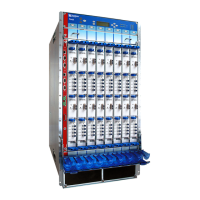The following sample calculation for a 2-km-long multimode link with a power budget
(P
B
) of 13 dB uses the estimated values from Table 81 on page 143 to calculate link loss
(LL) as the sum of fiber attenuation (2 km @ 1 dB/km, or 2 dB) and loss for five connectors
(0.5 dB per connector, or 2.5 dB) and two splices (0.5 dB per splice, or 1 dB) as well as
higher-order mode losses (0.5 dB). The power margin (P
M
) is calculated as follows:
P
M
= P
B
– LL
P
M
= 13 dB – 2 km (1 dB/km) – 5 (0.5 dB) – 2 (0.5 dB) – 0.5 dB
P
M
= 13 dB – 2 dB – 2.5 dB – 1 dB – 0.5 dB
P
M
= 7 dB
The following sample calculation for an 8-km-long single-mode link with a power budget
(P
B
) of 13 dB uses the estimated values from Table 81 on page 143 to calculate link loss
(LL) as the sum of fiber attenuation (8 km @ 0.5 dB/km, or 4 dB) and loss for seven
connectors (0.5 dB per connector, or 3.5 dB). The power margin (P
M
) is calculated as
follows:
P
M
= P
B
– LL
P
M
= 13 dB – 8 km (0.5 dB/km) – 7(0.5 dB)
P
M
= 13 dB – 4 dB – 3.5 dB
P
M
= 5.5 dB
In both examples, the calculated power margin is greater than zero, indicating that the
link has sufficient power for transmission and does not exceed the maximum receiver
input power.
Related
Documentation
• Understanding Fiber-Optic Cable Signal Loss, Attenuation, and Dispersion on page 141
Copyright © 2017, Juniper Networks, Inc.144
T640 Core Router Hardware Guide

